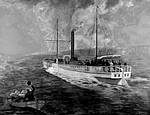Hudson Valley Museums and Organizations
The Hudson River, flowing for 315 miles from its source in the Adirondack Mountains to the Atlantic Ocean at New York City, has played an important role in our history. Even before Dutch and Germans settled its shores, the river was a major trade route for early Native Americans. Later, during Colonial times, it provided a means to transport products such as fur, wheat and timber. The Hudson River also played a pivotal role in the Revolutionary War.
The construction of the Erie Canal in 1820 connected the Hudson with the Great Lakes, opening a route westward. The creation of the Delaware and Hudson Canal a bit later provided access to Pennsylvania coalfields and facilitated the development of New York City.
The introduction of the steamship in 1807 carrying passengers and freight transformed river life. By the 19th century the dramatic scenery along the Palisades, Hudson Highlands and Catskills drew thousands of visitors and inspired artists and writers who celebrated its beauty in images and prose. Work by Hudson River School painters traveled abroad and helped create a cultural identity for the young nation.
The following is a brief look at some of the organizations and museums focused on preserving the life and the history of the Hudson River:
The Historical Society of Rockland County
As part of Rockland County’s celebration of the New York State Quadricentennial, The Historical Society of Rockland County will present the exhibition, The Tappan Zee Bridge: Transforming Rockland County.
The exhibition about the Tappan Zee Bridge and its great impact on our county will show the circumstances and politics of building the bridge, its connection to the NYS Thruway and how the bridge became an iconic image for Rockland County, inspiring thousands to settle in the area. Constructed in 1955, the bridge symbolizes the new suburb that was created practically overnight. The story of the bridge will be told through rare photographs and drawings, blueprints, items from the opening day and oral histories from bridge workers.
An opening reception will be held Sunday, May 24, 2009, 1:00 to 5:00 pm. The exhibition runs through October. Museum hours: Tuesdays through Sundays, 1:00 pm. to 5:00 pm. The museum is located at 20 Zukor Road, New City.
Scenic Hudson
Scenic Hudson began its Hudson Valley crusade in 1963 with an effort to save Storm King Mountain when Con Edison presented a proposal to build the world’s largest pumping-storage hydroelectric plant. After winning its 17-year battle, local communities turned to Scenic Hudson for guidance; this led to the formation of programs that dealt with air and water quality issues and community planning needs.
During the 70s, Scenic Hudson formed a separate land trust to expand its conservation work through land acquisition and land protections via easements. At this time a campaign was launched advocating the removal of PCBs from the Hudson River.
Today, with 20,000 supporters, Scenic Hudson is the largest environmental group focused on the Hudson River Valley. The organization has been successful in getting 1,000 Hudson Highland sites listed on state and national registers and is credited with launching the grass-roots environmental movement and winning citizens the right to initiate environmental lawsuits.
The Hudson River Museum
The Hudson River Museum, located at 511 Warburton Avenue, Yonkers, includes Glenview, an 1876 restored home; the Andreus Planetarium and Hudson Riverama, a permanent environmental gallery as well as exhibits on regional history, art and environmental science. The museum is marking the anniversary of Hudson’s voyage with an exhibition, Dutch New York: The Roots of Hudson Valley Culture, opening June 13, 2009 and running to January 10, 2010. Three years in the making, it follows the story of the waxing and waning of Dutch influence in America that began with Hudson’s voyage aboard the Half Moon in 1609 to the New World for the Dutch East India Company.
This exhibit encompasses four centuries of local Dutch heritage. Key times are investigated. These are 1609, when the Half Moon entered New York Harbor; 1809, Half Moon exploratory vessel as well as a 1909 model of the ship.
The show includes accoutrements used during Hudson’s voyage, an historic timeline and murals depicting Native Americans seen by Hudson.
Small Steamboats of the Hudson, a complementary exhibition, tells the history and role played by short distance steamboats that transported people and goods up and down the Hudson river.
The museum is open May through October, 11:00am to 5:00pm


